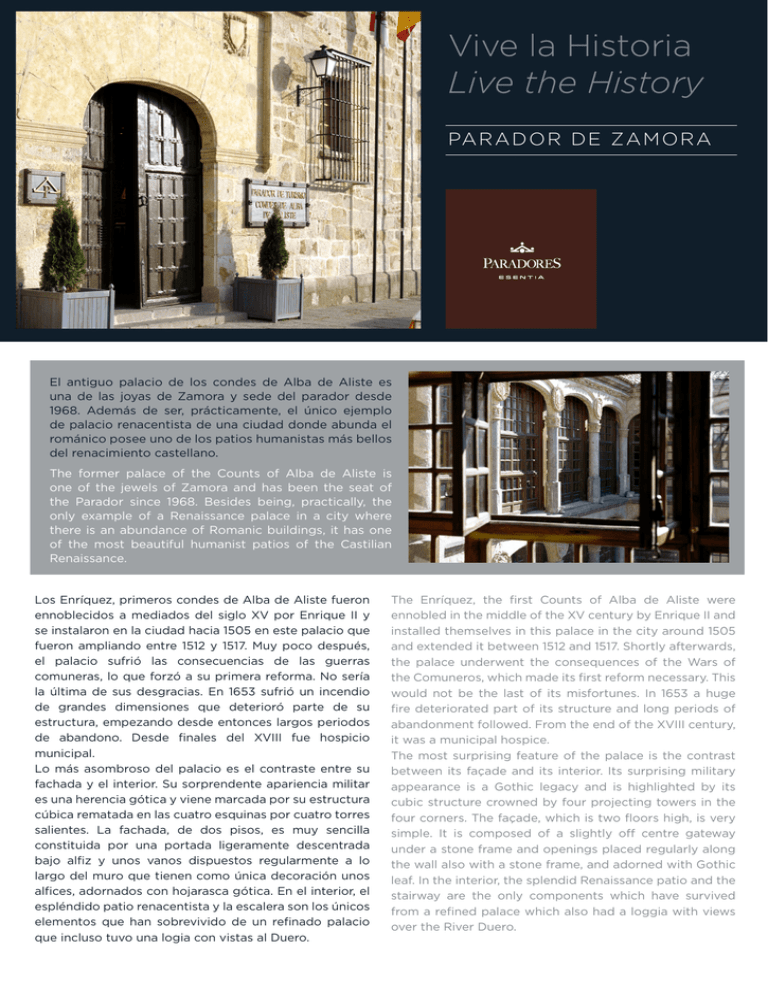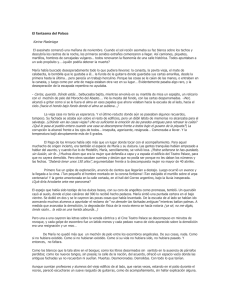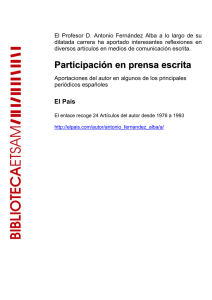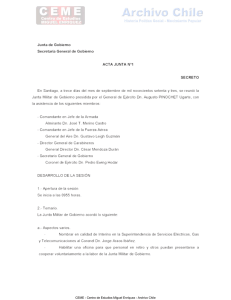Folleto Vive la Historia. Parador de Zamora
Anuncio

Vive la Historia Live the History PARADOR DE ZAMORA El antiguo palacio de los condes de Alba de Aliste es una de las joyas de Zamora y sede del parador desde 1968. Además de ser, prácticamente, el único ejemplo de palacio renacentista de una ciudad donde abunda el románico posee uno de los patios humanistas más bellos del renacimiento castellano. The former palace of the Counts of Alba de Aliste is one of the jewels of Zamora and has been the seat of the Parador since 1968. Besides being, practically, the only example of a Renaissance palace in a city where there is an abundance of Romanic buildings, it has one of the most beautiful humanist patios of the Castilian Renaissance. Los Enríquez, primeros condes de Alba de Aliste fueron ennoblecidos a mediados del siglo XV por Enrique II y se instalaron en la ciudad hacia 1505 en este palacio que fueron ampliando entre 1512 y 1517. Muy poco después, el palacio sufrió las consecuencias de las guerras comuneras, lo que forzó a su primera reforma. No sería la última de sus desgracias. En 1653 sufrió un incendio de grandes dimensiones que deterioró parte de su estructura, empezando desde entonces largos periodos de abandono. Desde finales del XVIII fue hospicio municipal. Lo más asombroso del palacio es el contraste entre su fachada y el interior. Su sorprendente apariencia militar es una herencia gótica y viene marcada por su estructura cúbica rematada en las cuatro esquinas por cuatro torres salientes. La fachada, de dos pisos, es muy sencilla constituida por una portada ligeramente descentrada bajo alfiz y unos vanos dispuestos regularmente a lo largo del muro que tienen como única decoración unos alfices, adornados con hojarasca gótica. En el interior, el espléndido patio renacentista y la escalera son los únicos elementos que han sobrevivido de un refinado palacio que incluso tuvo una logia con vistas al Duero. The Enríquez, the first Counts of Alba de Aliste were ennobled in the middle of the XV century by Enrique II and installed themselves in this palace in the city around 1505 and extended it between 1512 and 1517. Shortly afterwards, the palace underwent the consequences of the Wars of the Comuneros, which made its first reform necessary. This would not be the last of its misfortunes. In 1653 a huge fire deteriorated part of its structure and long periods of abandonment followed. From the end of the XVIII century, it was a municipal hospice. The most surprising feature of the palace is the contrast between its façade and its interior. Its surprising military appearance is a Gothic legacy and is highlighted by its cubic structure crowned by four projecting towers in the four corners. The façade, which is two floors high, is very simple. It is composed of a slightly off centre gateway under a stone frame and openings placed regularly along the wall also with a stone frame, and adorned with Gothic leaf. In the interior, the splendid Renaissance patio and the stairway are the only components which have survived from a refined palace which also had a loggia with views over the River Duero. LOS ENRÍQUEZ, UN LINAJE CASTELLANO El título de condes de Alba de Aliste fue concedido en 1459 por Enrique IV a don Enrique Enríquez (1406-1481), hijo del Primer Almirante de Castilla, y a su mujer doña María de Guzmán. Aunque fueron su padre y hermano, los dos primeros almirantes de Castilla, los que más fama han dado al linaje, Enrique Enríquez, dueño del palacio zamorano fue un importante señor feudal en la Castilla del siglo XV. Si bien comenzó mostrándose fiel a Enrique IV, pronto se mostró partidario del matrimonio de Isabel de Castilla y Fernando de Aragón, que tenía sangre Enríquez por vía materna. Tanto que, a pesar de su madurez, fue hecho prisionero por los partidarios de la Beltraneja. Tras su breve prisión se refugió en su palacio de Zamora donde fallecería poco después. El compromiso de los Enríquez con la monarquía se mantuvo intacto con el nuevo monarca, Carlos V, durante la guerra de los comuneros que llegaron a tomar y asaltar su palacio zamorano. Señores de un territorio conocido como Tierra de Alba, se convirtieron en una de las familias más poderosas de Castilla gracias a su riqueza, vinculada a la Mesta y a una red de alianzas matrimoniales que les llevaron a emparentar ya en el siglo XVI con los duques de Alba de Tormes. THE ENRÍQUEZ, A CASTILIAN LINEAGE The title of Counts of Alba de Aliste was conferred in 1459 by Enrique IV to Enrique Enríquez (1406-1481), the son of the First Admiral of Castile and his wife María de Guzmán. Although the first two Admirals of Castile were his father and brother, the person who made the lineage more famous was Enrique Enríquez, the Lord of the palace of Zamora, who was an important feudal lord in the Castile of the XV century. Although at the beginning, he appeared to be loyal to Enrique IV, he soon became a supporter of the marriage of Isabel de Castilla and Fernando de Aragón, who had Enríquez blood on the maternal side. Despite his mature age, he was made a prisoner by the supporters of La Beltraneja. After a brief period in prison, he took refuge in the palace of Zamora where he later died. The commitment of the Enríquez with the monarchy remained intact with the new monarch, Carlos V, during the War of the Comuneros who attacked and took their palace of Zamora. They were the lords of the territory known as Tierra de Alba and became one of the most powerful families of Castile thanks to their wealth, linked to the Mesta and a network of matrimonial alliances which led to them becoming related to the Dukes of Alba de Tormes in the XVI century. UN PATIO HUMANISTA Estamos en un patio de gran valor simbólico e iconográfico relacionado con el ideal humanista del “templo de la fama”, una tipología muy frecuente en el renacimiento italiano. Los señores del palacio elegían como motivo decorativo el ideal en que querían mirarse, y los Enríquez, orgullosos y fieles soldados, reprodujeron en su palacio en veinte medallones los guerreros más ilustres de la antigüedad y la Historia de España. A HUMANIST PATIO We are in a patio with a substantial symbolic and iconographic value related to the humanist ideal of the “temple of fame”, a very frequent typology in the Italian Renaissance. The Lords of the palace chose the ideal they wished to emulate as the decorative motif and the Enríquez, proud and loyal soldiers, reproduced the most illustrious warriors of antiquity and of the history of Spain in twenty medallions. TAMBIÉN LE GUSTARÁ: YOU WILL ALSO LIKE THE FOLLOWING: Zamora (ruta del románico). Zamora (Romanic rout) Toro: Colegiata de Santa María la Mayor. Toro: Colegiata de Santa María la Mayor San Pedro de la Nave (iglesia visigoda del siglo VII). San Pedro de la Nave (VII century Visigoth church) Categoría: Palacio Fecha: 1968 Arquitecto: Jesús Valverde BIC: Monumento Category: Palace Date: 1968 Architect: Jesús Valverde BIC (Property of Cultural Interest): Monument



